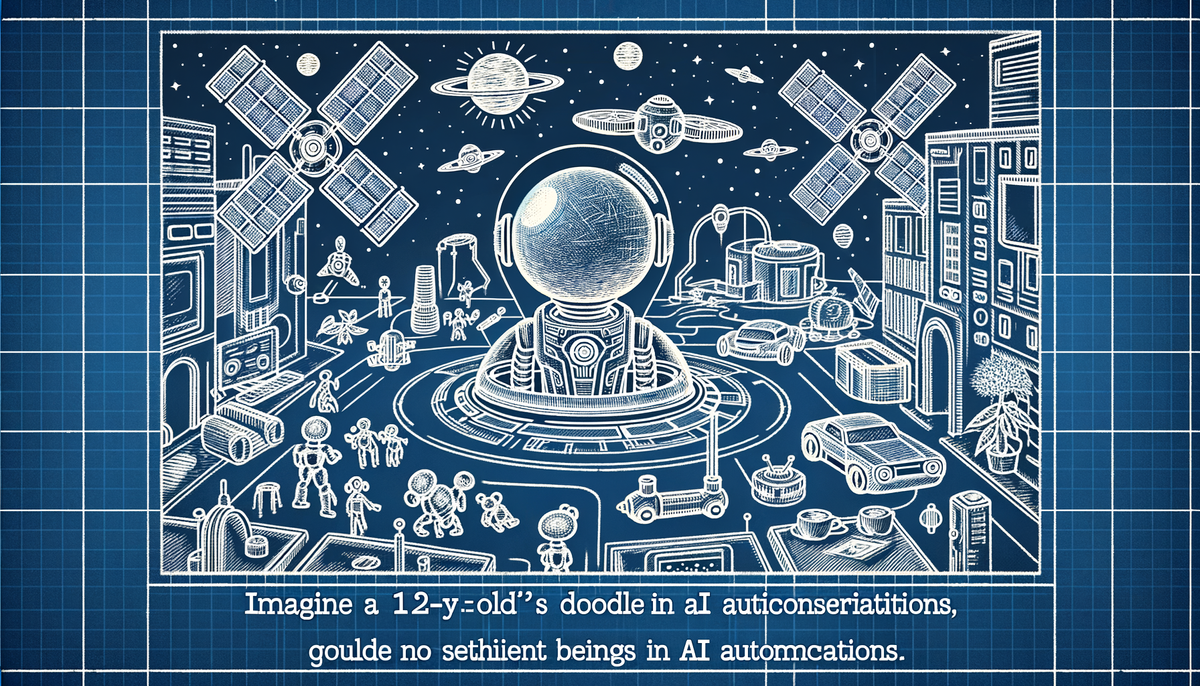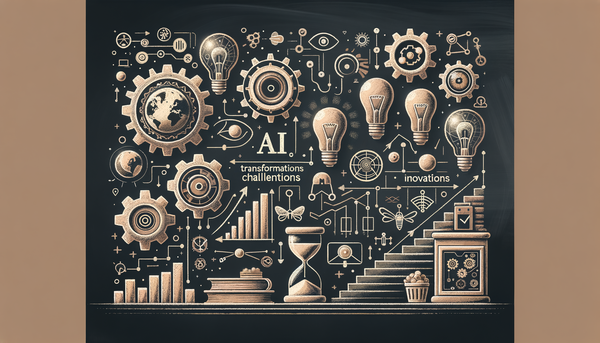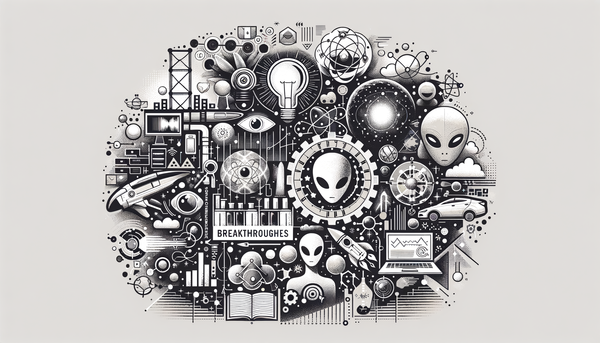AI Updates: Microsoft's Vision for Inclusive Innovation

This article delves into the transformative power of artificial intelligence across diverse domains—from Europe's strategic focus on ethical, collaborative innovation and tailored SME support, through AI’s controversial use in storytelling within sports entertainment, to groundbreaking enterprise solutions, the evolution toward People-Centric AI, and heated debates on hardware pricing—providing an in-depth analysis of both technological advancements and the strategic shifts redefining today’s AI landscape.
The European AI Landscape: Collaboration, Specialty, and Ethical Innovation
Europe is positioning itself as a potential AI superpower, not by competing head-on with the vast resources of the United States, but by leveraging a unique mix of specialization, collaboration, and an unwavering commitment to ethical AI. As highlighted in the insightful coverage from Entrepreneur, the continent is investing a colossal €200 billion to nurture AI advancements that emphasize responsibility and targeted innovation over sheer scale. The focus on niche markets—such as explainable language models, revolutionized drug discovery, and application-specific AI solutions—enables Europe to build a robust ecosystem that caters to its diverse industries and SMEs.
One of the most striking examples of this approach is seen in projects like France’s Mistral, which underscores the idea that success in AI is not exclusively ensured by access to superior chips or massive capital. European startups, including Germany’s Aleph Alpha and the UK's Causaly, are showing that agility, coupled with strict compliance to ethical standards, fosters an environment where groundbreaking AI solutions can thrive. These companies have capitalized on their crisp focus, developing technologies that are both innovative and ethically sound, which is a testament to Europe’s broader strategy of competing on quality and specialization.
Despite this impressive progress, a key challenge remains: the adoption of these advanced AI solutions by small- and medium-sized enterprises (SMEs). As estimated, a staggering 65% of French SMEs and 43% of UK SMEs have yet to fully harness the benefits of emerging AI technologies, potentially stagnating the broader economic benefits that widespread AI integration might bring. Initiatives like the AI Navigator are emerging to bridge this gap by providing tailored support, resources, and predictive analytics tools that empower SMEs to remain competitive in an increasingly digital marketplace.
Furthermore, Europe’s commitment to responsible AI including a comprehensive regulatory approach—the EU's AI Act—lays down a framework that both protects citizens and fosters innovation. This regulatory model is garnering global attention and is cross-referenced with discussions in our article on Collaboration Will Create an AI Superpower and Why SMEs are Key on AI.Biz, outlining a future where ethical responsibility and business growth go hand in hand.
"A robot may not injure a human being, or, through inaction, allow a human being to come to harm." - Narration (The Three Laws of Robotics)
This vision reflects a broader existential debate: AI must do more than deliver efficiency—it must protect and empower society. The emphasis on a responsible, specialized approach could very well carve a unique competitive advantage for Europe as it endeavors to build a truly human-centric AI ecosystem.
The Fusion of Creativity and Technology: AI in Sports Entertainment
An unexpected yet fascinating arena for AI innovation is professional sports entertainment, where technology is interweaving with storytelling to create immersive experiences. A recent example saw the emergence of the enigmatic character El Grande Americano on WWE RAW, whose backstory was dynamically generated using AI. This development sparked debates about the balance between technological innovation and the intrinsic human touch that has historically defined creative storytelling.
AI-generated narratives in the sports arena are a double-edged sword. On the one hand, they introduce fresh, innovative approaches to storyline creation, offering a level of creativity that can be precisely tailored to fan sentiments. On the other, as noted in the coverage by Yahoo Sports, there are concerns that overreliance on technology could diminish the authenticity of characters and story arcs—elements that fans have cherished for decades.
In a dramatic twist reminiscent of method acting and immersive theatre, the character—allegedly portrayed by Chad Gable—embodied both athletic brilliance and narrative complexity. His triumphant display against Dragon Lee illustrated that even when AI is used for crafting dramatic backstories, the inherent energy and unpredictability of live sports remain dominantly human. This phenomenon introduces a pivotal question: can AI-generated content truly resonate with audiences who cherish the imperfections and spontaneity of human creativity?
While some fans laud the infusion of high-tech innovation, many remain wary, emphasizing that the raw, emotional intensity of professional wrestling is something that no algorithm can replicate. This delicate balance between innovation and authenticity is a recurring theme across industries as AI continues to encroach into creative spaces. Linking this topic with our ongoing exploration of AI in enterprise in our piece on NetSuite Expands AI Capabilities and the Rise of Intelligent Solutions on AI.Biz underscores that the broader challenge lies in harmonizing advanced technology with our innate need for genuine human expression.
In a broader cultural context, the debate around AI’s role in storytelling echoes historical concerns about technology in art—a discourse that dates back to early days of automation in film and literature. Today, audiences demand that while technology enhances the narrative, it does not supplant the human spark, a sentiment many express as a plea for maintaining authenticity in the creative process.
Enterprise Transformation: Cognizant's Neuro AI and Cost-Saving Paradigms
On the enterprise front, artificial intelligence continues its relentless march towards transforming operations and slashing costs. Cognizant’s latest venture—a breakthrough Neuro AI platform, formed in a strategic partnership with NVIDIA—is a prime example of how AI adoption in the corporate world is evolving. According to the detailed analysis by StockTitan, Cognizant’s innovative platform targets key areas including enterprise AI agents, industry-specific large language models (LLMs), digital twins for smart manufacturing, and foundational AI infrastructure.
What stands out about Cognizant’s approach is the quantifiable impact of their AI-driven solutions. By achieving up to a 75% reduction in operational expenses, their technology is not only about efficiency—it’s about redefining the competitive dynamics for enterprises. For instance, the healthcare-focused LLM integrated within this platform has delivered improvements in coding accuracy and accelerated go-to-market timelines, thereby providing tangible financial returns. This is particularly crucial in an era where businesses are more than ever pressed by the need for cost-effective, robust, and agile technology solutions.
The partnership with NVIDIA further amplifies this competitive advantage. By integrating digital twins and leveraging NVIDIA’s GPU capabilities for “GPU as a Service,” Cognizant has been able to simulate manufacturing scenarios, enhance real-time insights, and optimize resource allocation. Such innovations not only help mitigate risk but also empower businesses to make informed, data-backed decisions—a significant leap in operational sophistication.
Furthermore, this transition signifies more than just cost savings; it embodies the maturation of enterprise AI from speculative experimentation to practical, full-scale implementations. Cognizant's journey is emblematic of a broader trend within the technology sector where companies are recalibrating their roles from traditional IT service providers to comprehensive AI orchestration partners. This strategic pivot is deeply tied to ongoing conversations on AI transformation outlined in our article on AI Transformations: The Convergence of Innovation and Ethics on AI.Biz, where the dual imperatives of ethical consideration and business efficiency are increasingly recognized as intertwined drivers of success.
The success of Cognizant’s platform also provides a glimpse into the future of enterprise technology. Industries that adopt such frameworks can expect rapid transition phases from pilot projects to wide-reaching implementations, driven by enhanced operational analytics. As organizations begin to recognize the potential of tailored LLMs and digital twin technologies, a robust ecosystem of AI-enabled enterprises is likely to emerge, setting a new benchmark for cost control, scalability, and smart manufacturing.
From Physical AI at the Edge to People-Centric AI: Microsoft's Vision for a Humane Future
At the Ability Summit 2025, Microsoft took center stage with a clarion call for a fundamental shift in the way we design and deploy artificial intelligence. Moving away from the traditional reliance on physical AI at the edge—which primarily harnesses data collection and real-time analytics—Microsoft advocated for a People-Centric AI approach. The transformative idea is simple yet powerful: technology must evolve into a tool that truly empowers individuals, particularly those with unique challenges such as disabilities.
This new paradigm envisions AI systems that are not only technically proficient but are also deeply inclusive and empathetic. By incorporating user feedback and prioritizing accessibility, People-Centric AI is poised to bridge gaps that have historically left marginalized groups underserved. The innovations unveiled at the summit—ranging from breakthroughs in natural language processing to machine learning models fine-tuned to interpret contextual cues—signal a commitment to enhancing lives rather than merely optimizing industrial processes.
In practical terms, People-Centric AI can revolutionize how differently-abled individuals interact with technology. Imagine AI tools capable of real-time language translation or contextual understanding that adapt to diverse communication needs. Such applications extend far beyond entertainment or administrative functions: they represent a significant stride toward equity and inclusion in the digital age.
This focus on inclusivity is not just an altruistic gesture, but a strategic imperative. Companies embracing People-Centric AI stand to unlock new opportunities in markets that have been previously overlooked. Microsoft's vision is a potent reminder that as AI becomes more integrated into everyday life, it must not lose sight of its ultimate purpose—enhancing the human experience.
Critically, the evolving notion of People-Centric AI is characterized by a collaborative ethos. It calls for input from all stakeholders—developers, end-users, governments, and advocacy groups—in order to create systems that are not only technically advanced but also socially responsible. This shift mirrors sentiments expressed in our earlier discussion on OpenAI's Case for Freedom in Regulation on AI.Biz, where balancing innovation with ethical oversight is underscored as being essential in forwarding the broader AI agenda.
"Science Fiction, is an art form that paints a picture of the future." - A.R. Merrydew, Inara
The philosophical underpinnings of People-Centric AI invite us to reconsider what true progress means in the context of technological advancement. While it is tempting to view AI solely as a means for enhancing productivity and profitability, it is equally important to acknowledge its potential in shaping a more inclusive, accessible, and empathetic world.
Pricing and the Economics of AI Hardware: A Heated Industry Debate
No conversation about AI is complete without addressing the economic realities that underpin its rapid evolution. At Nvidia’s 2025 GPU Technology Conference, former Intel CEO Pat Gelsinger ignited a spirited debate by challenging Nvidia's pricing strategy for their AI chips. Gelsinger’s assertion—that the cost of current AI processors is exorbitant and unsustainable, especially for large-scale inference—struck a chord within the industry and raised pivotal questions about the long-term viability of such pricing models.
The heart of the argument lies in the shift from training models, which are resource-intensive but performed irregularly, towards inference, the stage that deploys AI models continuously in live applications. For mass adoption, cost-effectiveness in inference is non-negotiable. Gelsinger argued that Nvidia’s advanced GPUs and associated hardware might be priced as much as 10,000 times higher than what would be commercially reasonable for widespread use. Such critiques force us to re-examine the value proposition offered by high-end AI hardware and the competitive dynamics that drive pricing strategies.
Yet, it’s critical to recognize that while Gelsinger's commentary was undeniably pointed, it also acknowledges Nvidia’s pioneering role in propelling generative AI forward through innovations in GPU technology and CUDA software. Even as the former CEO critiqued the pricing, there was an underlying respect for the technological feats enabled by Nvidia’s leadership, with a notable nod to CEO Jensen Huang’s contributions—albeit with a controversial remark that "Jensen got lucky." This layered debate, which spans the complex interplay of technological supremacy, market strategy, and competitive pricing, is reflective of the ongoing tug-of-war in the AI hardware space.
Moreover, the ensuing dialogue around AI hardware pricing has significant broader implications. As traditional computing paradigms begin to converge with new-age quantum computing and next-generation inference mechanisms, the cost dynamics of AI deployment are likely to evolve in unpredictable ways. Former Intel’s refocusing efforts—shifting from the Falcon Shores AI platform to the nascent Jaguar Shores project—underscore the urgency for companies to rethink their AI strategies in the face of skyrocketing demands for affordable processing power.
This debate echoes a recurrent theme throughout the AI discourse: the tension between cutting-edge advancements and the accessibility required for mass adoption. While high performance and state-of-the-art capabilities remain desirable, the ultimate success hinges on how technology can be democratized without compromising on quality. For a more comprehensive discussion on this paradigm, our readers might find the conversation on our article, OpenAI's Case for Freedom in Regulation, particularly illuminating regarding the balance between innovation and market realities.
In reflecting on these dynamics, I often recall a popular adage: "Innovation is the ability to see change as an opportunity – not a threat." The argument presented by Gelsinger serves as a pragmatic checkpoint for the industry, urging stakeholders to balance the scales between technological excellence and economic viability. It is clear that as the landscape of AI hardware continues to evolve, the pursuit of cost-effective, high-performance solutions will remain a critical challenge.
Balancing the Pillars of Progress: Collaboration, Innovation, and Governance
As we synthesize these diverse narratives—from the strategic evolution of Europe’s AI ecosystem and enterprise innovations by Cognizant, to the creative experiments in sports entertainment and the fundamental reorientation toward People-Centric AI—one overarching theme emerges: collaboration. Whether it’s through transnational partnerships, cross-industry alliances, or integrated regulatory frameworks, the future of AI hinges on the ability to harness collective expertise and shared vision.
This collaborative spirit is evident not only in how startups and large corporations are framing their innovations, but also in the ongoing dialogue surrounding AI ethics, governance, and the democratization of technology. The European model, which emphasizes ethical standards and specialized innovation, provides a blueprint for how inter-sectoral collaboration can lead to sustainable growth. Similarly, the enterprise transformation led by Cognizant—bolstered by strategic partnerships with tech giants like NVIDIA—demonstrates how seamlessly intertwined innovation and business strategy have become in today’s AI landscape.
Moreover, the inclusive approach championed by Microsoft at the Ability Summit 2025 further reinforces the notion that technology must ultimately serve humanity—a point reiterated in several of our articles on AI.Biz, including those examining the expansive role of AI in both business and regulatory contexts. This convergence of technological prowess, ethical consideration, and collective governance underscores the profound impact of AI not merely as a tool for progress but as a catalyst for societal transformation.
The way forward for AI, therefore, is not about isolated advancements but about harnessing the strengths of diverse stakeholders—from policy makers and academic institutions to innovators and end-users. By creating ecosystems where collaboration is not only encouraged but institutionalized, we can stretch the boundaries of what AI can achieve, while ensuring that such progress aligns with the broader interests of society.
Indeed, the synthesis of progress across continents, industries, and applications illustrates a future rich with potential. As researchers continue to push the envelope of AI innovation, stories like these serve as timely reminders that technology is not an end in itself but a means to enhance our collective human experience.
Further Readings and Cross-References on AI.Biz
For those who would like to delve deeper into the topics discussed here, AI.Biz offers a range of articles that explore various facets of the AI revolution:
- How Collaboration Will Create an AI Superpower and Why SMEs are Key
- NetSuite Expands AI Capabilities and the Rise of Intelligent Solutions
- OpenAI's Case for Freedom in Regulation
- AI Transformations: The Convergence of Innovation and Ethics
These articles provide further context and analysis, offering a comprehensive view of how AI’s multifaceted impact is shaping our world—from regulatory innovations in Europe, transformative enterprise applications, and the creative reimagining of storytelling in sports entertainment, to the ongoing debates on AI hardware economics and the drive toward inclusive, People-Centric AI.
Conclusion
The narrative of artificial intelligence is complex, multifaceted, and continually evolving. By examining the European drive for ethical, collaborative innovation, the cutting-edge enterprise solutions redefining operational efficiency, the creative experiments that blur the boundaries between technology and storytelling, and the strategic debates surrounding AI hardware pricing, we gain a panoramic view of an industry in flux. Each of these domains contributes to a broader tapestry where progress is measured not solely by technological advancements but by how well these innovations resonate with fundamental human values.
In embracing both the opportunities and challenges presented by AI, businesses and innovators are laying the groundwork for a future that is as inclusive as it is technologically advanced. The evolving dynamics call for a balanced approach—one that champions collaboration, respects ethical boundaries, and remains ever-adaptive to the changing contours of technology. As we look ahead, it is this very balance that will determine whether AI becomes a tool for upliftment and empowerment or simply an emblem of competitive prowess. Ultimately, the journey of artificial intelligence is a shared one—a journey that benefits from collective insight, thoughtful governance, and a commitment to harnessing technology for the greater good.




